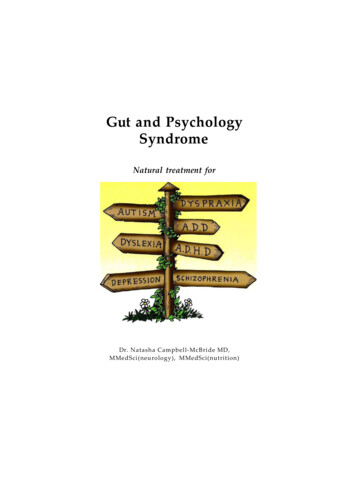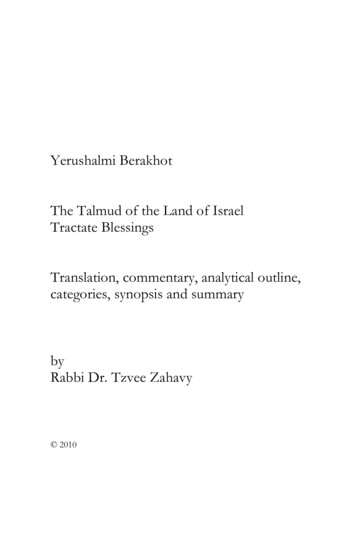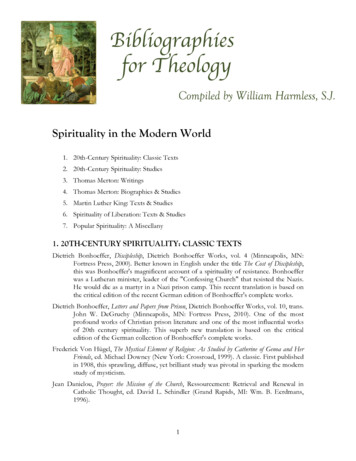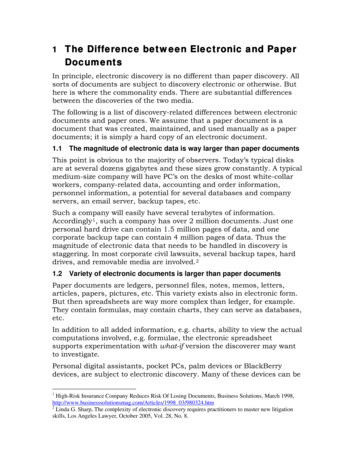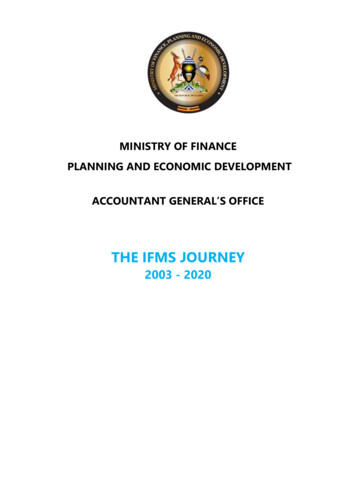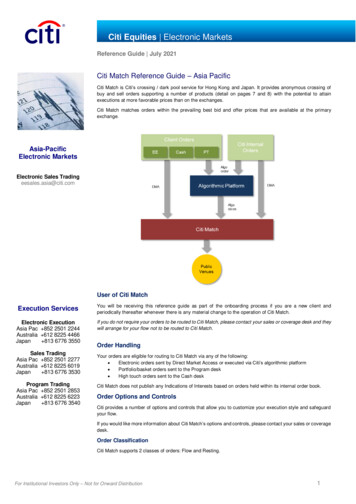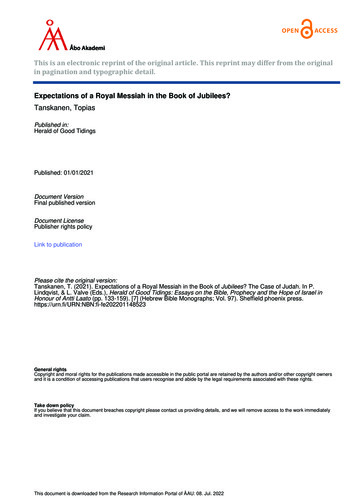
Transcription
This is an electronic reprint of the original article. This reprint may differ from the originalin pagination and typographic detail.Expectations of a Royal Messiah in the Book of Jubilees?Tanskanen, TopiasPublished in:Herald of Good TidingsPublished: 01/01/2021Document VersionFinal published versionDocument LicensePublisher rights policyLink to publicationPlease cite the original version:Tanskanen, T. (2021). Expectations of a Royal Messiah in the Book of Jubilees? The Case of Judah. In P.Lindqvist, & L. Valve (Eds.), Herald of Good Tidings: Essays on the Bible, Prophecy and the Hope of Israel inHonour of Antti Laato (pp. 133-159). [7] (Hebrew Bible Monographs; Vol. 97). Sheffield phoenix ral rightsCopyright and moral rights for the publications made accessible in the public portal are retained by the authors and/or other copyright ownersand it is a condition of accessing publications that users recognise and abide by the legal requirements associated with these rights.Take down policyIf you believe that this document breaches copyright please contact us providing details, and we will remove access to the work immediatelyand investigate your claim.This document is downloaded from the Research Information Portal of ÅAU: 08. Jul. 2022
EJR? TMCBJTopias K.E. Tanskanen1. IntroductionProfessor Antti Laato’s long-time interest has been the Messiah frommany different perspectives. From his doctoral dissertation Who isImmanuel? (1988) up to the present with Who is the Servant of the Lord?(2013) professor Laato has studied not only the precursors of messianicexpectations in Judaism, but also their reception history in Judaism andChristianity.1 It is my privilege to contribute to this Festschrift in honourof my encouraging and always excited supervisor by reopening the casefor messianic expectations in the book of Jubilees.Messianism and messianic expectations in early Judaism were muchdiscussed during the 1990s and 2000s. Several monographs and articleswere written particularly about the Dead Sea Scrolls.2 This is no surprise,1. Antti Laato, Who is Immanuel? The Rise and the Foundering of Isaiah’sMessianic Expectations (PhD diss., Åbo: Åbo Akademi Press, 1988); idem, Josiahand David Redivivus: The Historical Josiah and the Messianic Expectations ofExilic and Postexilic Times (ConBOT, 33; Stockholm: Almqvist & Wiksell International, 1992); idem, The Servant of YHWH and Cyrus: A Reinterpretation of theExilic Messianic Programme in Isaiah 40–55 (ConBOT, 35; Stockholm: Almqvist &Wiksell International, 1992); idem, A Star Is Rising: The Historical Development ofthe Old Testament Royal Ideology and the Rise of the Jewish Messianic Expectations(International Studies in Formative Christianity and Judaism; Atlanta, GA: ScholarsPress, 1997); idem, Who is the Servant of the Lord? Jewish and Christian Interpretations on Isaiah 53 from Antiquity to the Middle Ages (SRB, 4; Winona Lake, IN:Eisenbrauns, 2012).2. See, e.g., Jacob Neusner, William S. Green and Ernest Frerichs (eds.), Judaismsand their Messiahs at the Turn of the Christian Era (Cambridge: Cambridge University Press, 1987); James H. Charlesworth (ed.), The Messiah: Developments in
134Herald of Good Tidingsgiven that the scrolls finally became available for all scholars from theearly 1990s on.The book of Jubilees was discussed in some of the scholarly worksduring this period. Whereas in particular earlier research on Jubileessaw some traits of messianic expectations in the book,3 later scholarshave been more careful in their considerations.4 Some have concludedEarliest Judaism and Christianity (The First Princeton Symposium on Judaism andChristian Origins; Minneapolis, MN: Fortress Press, 1992); Craig A. Evans, Jesus andhis Contemporaries: Comparative Studies (AGJU, 25; Leiden: Brill, 1995); James H.Charlesworth, Hermann Lichtenberger and Gerbern S. Oegema (eds.), Qumran-Messianism: Studies on the Messianic Expectations in the Dead Sea Scrolls (Tübingen:Mohr Siebeck, 1998); Laato, Star is Rising; Johannes Zimmermann, MessianischeTexte aus Qumran: Königliche, priesterliche und prophetische Messiasvorstellungenin den Schriftfunden von Qumran (WUNT, 2.104; Tübingen: Mohr Siebeck, 1998);Andrew Chester, Messiah and Exaltation: Jewish Messianic and Visionary Traditionsand New Testament Christology (WUNT, 1.207; Tübingen: Mohr Siebeck, 2007);Stanley E. Porter (ed.), The Messiah in the Old and New Testaments (McMaster NewTestament Studies; Grand Rapids, MI: Eerdmans, 2007). An updated bibliographyon the subject up to 2010 can be found in John J. Collins, The Scepter and the Star:Messianism in Light of the Dead Sea Scrolls (Grand Rapids, MI: Eerdmans, 2ndedn, 2010), pp. 238-73. The first edition was published 1995. On the new phase inQumran studies and messianism in the 1990s, see Zimmermann, Messianische Texte,pp. 13-15.3. Roland H. Charles, The Book of Jubilees or the Little Genesis (London: Adam& Charles Black, 1902), pp. lxxxvii, 188; idem, ‘The Book of Jubilees’, in Roland H.Charles (ed.), The Apocrypha and Pseudepigrapha of the Old Testament in English(Oxford: Clarendon Press, 1913), II, pp. 1-82 (1, 9, 61); Sigmund Mowinckel, Hethat Cometh (trans. G. W. Anderson; New York: Abingdon Press, 1956), pp. 280,286-88, 316, 323, who on one hand emphasizes that only the line of Levi inheritsthe messianic promises (‘The book of Jubilees knows nothing of a future monarchyof the house of Judah, but only of the house of Levi’, p. 287), but on the other handuses Jub. 31.20 in his reconstruction of what happens when the messiah arrives(p. 316); Klaus Berger, Das Buch der Jubiläen (JSHRZ, 2.3; Gütersloh: GütersloherVerlagshaus Gerd Mohn, 1981), p. 471; Marinus de Jonge, ‘Messiah’, in ABD, IV,pp. 777-88 (782).4. Collins, Scepter and Star, pp. 95-96; James L. Kugel, A Walk through Jubilees:Studies in the Book of Jubilees and the World of its Creation (JSJSup, 156; Leiden:Brill, 2012), p. 151; James C. VanderKam, Jubilees: A Commentary (Hermeneia;Minneapolis, MN: Fortress Press, 2018), p. 859. Zimmermann, Messianische Texte,pp. 231-32, refers to Collins and agrees with him. See also James M. Scott, On Earthas in Heaven: The Restoration of Sacred Time and Sacred Space in the Book ofJubilees (JSJSup, 91; Leiden: Brill, 2004), pp. 173-77.
TExpectations of a Royal Messiah in the Book of Jubilees?135that such expectations cannot be discerned from Jubilees.5 A tendency inrecent works seems to be to exclude Jubilees from discussion, mostly duemethodological questions.6However, in his Star is Rising (1997), Laato analysed Jubilees as a partof literature from the Hasmonean period, focusing on the portrait of Leviand Judah, and Isaac’s blessing of them in Jubilees 30–32.7 According toLaato, the Davidical expectations were de-emphasized in Jubilees, but notnullified completely. He connects this tendency to the political situationof Judea, where Levite Maccabeans held the political power. Given thatafter Isaac’s blessing of Levi and Judah Jacob states that he had ‘eternalhope before God’ (Jub. 31.32), it seems to Laato that these promises areregarded as eternally valid.8 He concludes:[A]s in the Book of Ben Sira, so also in the Book of Jubilees the OldTestament promises given to the dynasty of David were too many andtoo strong to be eliminated. In lieu of elimination, attempts were made todownplay their applicability to the current situation.9Laato’s analysis of messianic expectations in Jubilees is connected to hisreconstruction of downplayed expectations especially in Ben Sira fromaround the same period.10 In this contribution, however, it is impossible todelve deeply into the minefield of how widespread messianic expectationsactually were during the Persian and Hellenistic period.One shortfall in Laato’s short evaluation of messianic (or Davidic)expectations in Jubilees, however, is that he focuses solely on chs. 30–32and particularly on Isaac’s blessing of Levi and Judah, which certainly5. Gene Davenport, The Eschatology of the Book of Jubilees (SPB, 20; Leiden:Brill, 1971); William Scott Green, ‘Messiah in Judaism: Rethinking the Question’,in Neusner, Green and Frerichs (eds.), Judaisms and their Messiahs, pp. 1-13 (2).Chester, Messiah and Exaltation, does not deal with Jubilees almost at all. Wherehe refers to Jubilees, his views on messianic expectations there remain somewhatambiguous. Compare p. 275—where he refers to ‘priestly hope’ in Jubilees (alongsidewith royal?)—with p. 531: ‘There is no messianic figure here [Jub. 23] or elsewherein Jubilees’. Perhaps the choice not to see Jubilees as relevant for closer investigationindicates that Chester would answer negatively, too.6. For example, Jubilees is also almost totally absent in the contributions ofCharlesworth (ed.), The Messiah.7. Laato, Star is Rising, pp. 269-75.8. Laato, Star is Rising, pp. 274-75.9. Laato, Star is Rising, p. 275.10. Laato, Star is Rising, pp. 236-48.
136Herald of Good Tidingsremains the crux interpretum. A similar problem is also found in othercontributions regarding messianic expectations in Jubilees.11 What Iargue, however, is that in order to understand the thrust of the author ofJubilees, it is important to see how the author depicts Judah (and Levi) inthe whole work.In this contribution, I will analyse the portrait of Judah in Jubilees andany possible messianic overtones there. The portrait of Levi is less infocus here, since considerable research has already been done regardinghim in Jubilees, but there is far much less so regarding Judah.12 AlthoughJudah is the focus of this contribution, it should continuously be borne inmind that Jubilees 31, inter alia, clearly shows that Levi is the prominentone. It is portrayal of these two brothers that is at the fore when onediscusses possible messianism in Jubilees.First, however, what ‘messiah’ or ‘messianism’ means in this contextmust be defined. Different definitions of ‘messiah’ have been expounded,and have been helpfully organized by Andrew Chester.13 How theseterms are defined also influences the view the scholar has on messianicexpectations in general—and in Jubilees in particular.14 What I mean by11. E.g. Collins, Scepter and the Star, pp. 93-96; Zimmermann, MessianischeTexte, pp. 231-32; Eric F. Mason, ‘You Are a Priest Forever’: Second Temple JewishMessianism and the Priestly Christology of the Epistle to the Hebrews (STDJ, 74;Atlanta, GA: SBL Press, 2008), pp. 124-27.12. E.g. James L. Kugel, ‘Levi’s Elevation to the Priesthood in Second TempleWritings’, HTR 86 (1993), pp. 1-64; James C. VanderKam, ‘Jubilees and the PriestlyMessiah of Qumran’, in VanderKam, From Revelation to Canon: Studies in theHebrew Bible and Second Temple Literature (JSJSup, 62; Leiden: Brill, 2000),pp. 462-75; idem, ‘Jubilees’ Exegetical Creation of Levi the Priest’, in From Revelation to Canon, pp. 545-61; Robert A. Kugler, From Patriarch to Priest: TheLevi-Priestly Tradition from Aramaic Levi to Testament of Levi (EJL, 9; Atlanta,GA: Scholars Press, 1996); Lotta Valve, Early Modes of Exegesis: Ideal Figures inMalachi as a Test Case (Åbo: Åbo Akademi University Press, 2014), pp. 63-89.13. Chester, Messiah and Exaltation, pp. 193-205.14. For example, James H. Charlesworth, ‘From Messianology to Christology:Problems and Prospects’, in Charlesworth (ed.), The Messiah, pp. 3-35, defines‘messiah,’ and ‘messianology’ in such a way that only those texts which containthe term משיח or its equivalents in other languages are dealt with. When analysingmessianic expectations in OT Pseudepigrapha, he therefore excludes Jubilees fromdiscussion. This is the ‘minimalistic’ position criticised by Chester, Messiah andExaltation, pp. 193-96. Loren T. Stuckenbruck, ‘Messianic Ideas in the Apocalypticand Related Literature of Early Judaism’, in Porter (ed.), The Messiah of Old and NewTestaments, pp. 90-113, also narrows his survey terminologically in reaction against
TExpectations of a Royal Messiah in the Book of Jubilees?137‘messiah’ in this contribution is an eschatological figure that has a role toplay in those ‘last days’. The term ‘last days’ per se does not need to meanthe end of the world, but can perhaps be seen as more of a time betweentwo distinctive ages: the present one and the one to come.15 Thus, mydefinition resembles those proposed for example by Laato and Collins,and preferred by Chester.162. Judah in JubileesJudah is found in Jubilees in the following passages: 28.15, 17 (Judah’sbirth); ch. 31 (Jacob, Levi and Judah visit Rebekah and Isaac); 33.22(Jacob’s whole family visits Isaac and Rebekah); 34.5 (Judah along withJacob, Levi and Joseph stay with the aged Isaac); 34.20 (Judah marries aCanaanite woman); 38.1, 5 (Judah as a warrior leader in Jacob’s defenceagainst Esau and his sons); 41.1-18 (Judah and Tamar); and in chs. 42–44in the Joseph Story. I will analyse these texts in order, other than leavingthe analysis of ch. 31 to the end. The mention of Judah in Jub. 33.22 isirrelevant in this survey.One important question related to the portrait of Judah in the work isalso whether there are some redactions or not related to Isaac’s blessingof Levi and Judah.17 This is a question that I will tackle elsewhere. ToCharles’ interpretation of such passages where messiah is absent (e.g. Jub. 1.27-29and 23.26-31) as messianic. I applaud this kind of approach, when one at the sametime admits the methodological reduction, i.e., that the full picture can be, and in myopinion surely is, broader. This Stuckenbruck acknowledges (pp. 91-92).15. Concerning the problem of defining ‘eschatology’, see Mark J. Boda, ‘Figuringthe Future: The Prophets and Messiah’, in Porter (ed.), The Messiah in Old and NewTestaments, pp. 35-74 (40-43); George W.E. Nickelsburg, ‘Eschatology (EarlyJewish)’, in ABD, II, pp. 579-94 (esp. pp. 580, 591-93).16. Laato, Star is Rising, pp. 2-4, who however highlights the roots to royalideology and actually sees the messiah first and foremost as a royal figure; Collins,Scepter and Star, pp. 17-18: ‘a messiah is an eschatological figure who sometimes,but not necessarily always, is designated as משׁיח in the ancient sources’. Collinsemphasizes that the figure does not need to be royal per se, but could also he priestor a prophet. Chester, Messiah and Exaltation, p. 201. Already Mowinckel, He thatCometh, pp. 3, 451-52, emphasized the eschatological nature of ‘messiah’ against, forexample, Ivan Engnell.17. Such questions are raised by, e.g., Davenport, Eschatology of Jubilees, andChristoph Berner, ‘Jacob or Levi—Who is the Officiating Priest in Jubilees 30–32?’,JSP 26 (2016), pp. 20-31.
138Herald of Good Tidingsexpress my view bluntly here, Isaac’s Blessing of Levi and Judah has beenpart of the Jubilees from the very beginning.182.1. Judah’s Birth (Jubilees 28)The author of Jubilees added the chronological layout to the stories ofGenesis–Exodus, where events are dated according to their jubilees,weeks (of years), years, and even months and days. Clearly, calendricalmatters are important for him. In Jubilees 28, three of Jacob’s sons getsignificant dates of birth: Levi, Judah and Joseph.19 Levi is born on thefirst day of the first month (28.14), Judah on the fifteenth day of the thirdmonth (28.15), and Joseph on the first day of the fourth month (28.24).The most important date in Jubilees is arguably fifteenth of the thirdmonth (15/3), when the Festival of Weeks is celebrated.20 Given that Leviis the most important son of Jacob in Jubilees (Jub. 30–32, see below),VanderKam has pondered on why Levi is not given that very date, butthat it is given to Judah.21 Pauline P. Buisch has argued, in my opinionconvincingly, why Levi’s birthday is 1/1 while that of Judah falls on15/3.22Levi’s birthday is clearly associated with cultic matters, such assacrifices (Jub. 7.2-6; 24.21-23) and Bethel (27.19). Also, in the HebrewBible, this date is associated with the tabernacle (Exod. 40.2, 17) and the18. Unless noted otherwise, the English translation of Jubilees used is that ofVanderKam, Jubilees, which differs somewhat from his first translation in idem,The Book of Jubilees (CSCO, 511; SA, 88; Leuven: Peeters, 1989). The criticaledition of the Ethiopic version of Jubilees used here is based on 27 manuscripts andedited by VanderKam, The Book of Jubilees: A Critical Text (CSCO, 510; SA, 87;Leuven: Peeters, 1989). Since 1980s, the number of Ethiopic manuscripts identifiedas containing Jubilees has increased, the number now being over 50. On the newmanuscripts and their significance, see Ted Erho, ‘New Ethiopic witnesses to someOld Testament pseudepigrapha’, Bulletin of School of Oriental and African Studies,University of London 76.1 (2013), pp. 75-97; Matthew P. Monger, 4Q216: RethinkingJubilees in the First Century BCE (Oslo: MF Norwegian School of Theology, 2018),pp. 63-75; VanderKam, Jubilees, pp. 14-16.19. VanderKam, The Book of Jubilees (Guides to Apocrypha and Pseudepigrapha;Sheffield: Sheffield Academic Press, 2001), p. 64; Kugel, Walk through, p. 140.20. On the Festival of Weeks and its meaning in Jubilees, see Sejin Park, Pentecost and Sinai: The Festival of Weeks as a Celebration of the Sinai Event (LHBOTS,342; London: T&T Clark, 2008), pp. 78-127.21. VanderKam, Guide to Jubilees, p. 64.22. Pauline P. Buisch, ‘The Absence and Influence of Genesis 48 (the Blessing ofEphraim and Manasseh) in the Book of Jubilees’, JSP 26 (2017), pp. 255-73.
TExpectations of a Royal Messiah in the Book of Jubilees?139temple (2 Chron. 29.17; Ezek. 45.18-19).23 On the other hand, Judah’sbirthday (15/3) is the date on which the festival of the renewal of thecovenant is celebrated according to Jubilees. Buisch argues that Judahis associated with Festival of Weeks because promises given to Davidare interpreted as a covenant (2 Chron. 7.18; 21.7; Ps. 89.3).24 Thus, thebirthday of Levi reveals his future as priest, while Judah’s birthday isrelated to the Davidic covenant.2.2. Judah the Warrior (Jubilees 34 and 38)Jubilees 34.1-9 narrates a story that is not found in Genesis: it is anaggadic elaboration on a detail in Gen. 48.22, where Jacob says to Josephthat he had taken land from the Amorites with his ‘bow and sword’.Whereas the ‘bow’ part happens later, namely in ch. 38, the ‘sword’ fightagainst the Amorites takes place in Jub. 34.1-9.25Jacob had sent his sons (excluding Levi, Judah and Joseph) to tend hissheep on the plains of Shechem, when seven Amorite kings ally togetheragainst them. Jacob, Levi and Judah remain at home with their aged Isaacand the youngest son, Benjamin (Jub. 34.1-3).26 When Jacob hears of thisplot, he and his three sons (Levi, Judah and Joseph) set out against themwith servants and 6000 men, killing kings and requiring they pay tributeto him (34.4-9). The status of Levi and Judah is highlighted, as well asthe status of Joseph.27 This is similar to the three brothers’ dates of birth.23. Buisch, ‘Absence and Influence’, pp. 267-68; Hans A. Rapp, Jakob in Bet-El:Gen 35,1-15 und die jüdische Literatur des 3. und 2. Jahrhunderts (Herders BiblischeStudien, 29; Freiburg: Herder, 2001), p. 203; VanderKam, Jubilees, pp. 784-85;Topias K.E. Tanskanen, ‘ “He Established a Testimony in Jacob, He Set a Torah inIsrael”: Psalm 78 and the Book of Jubilees’, in Erkki Koskenniemi and David Willgren Davage (eds.), David, Messianism, and Eschatology: Ambiguity in the ReceptionHistory of the Book of Psalms in Judaism and Christianity (SRB, 10; Åbo: Networkfor the Study of the Reception History of the Bible, 2020), pp. 71-119 (104 n. 112).24. Buisch, ‘Absence and Influence’, p. 268; See also Tanskanen ‘He Established’,pp. 104-105, 107-108; Park, Pentecost and Sinai, pp. 122-25.25. Atar Livneh, ‘With My Sword and Bow: Jacob as Warrior in Jubilees’, inDevorah Dimant and Reinhard G. Kratz (eds.), Rewriting and Interpreting theHebrew Bible: The Biblical Patriarchs in the Light of the Dead Sea Scrolls (BZAW,439; Berlin: W. de Gruyter, 2013), pp. 189-213.26. Noteworthy is the addition ‘Benjamin was the youngest and therefore also heremained with Isaac’ (Jub. 34.3, own translation). Thus, the reason for Benjamin tostay at home is different.27. VanderKam, Jubilees, p. 921.
140Herald of Good TidingsJudah’s role as a warrior or leader is not highlighted here, but comes tothe fore in chs. 37 and 38.28Chapters 37–38 tell of a war between Esau and Jacob after their fatherIsaac died. In ch. 37, the sons of Esau become angry at Jacob’s familybecause they inherited everything owned by Abraham. Esau, his sons, andother nearby nations launch an assault against Jacob and his family whoreside at Hebron. After some disbelief about what is actually taking place,Jacob orders his house to go up against the opposing force. It is in thissituation that Judah takes the lead.When Jacob finally gives the order to attack Esau and his companions(Jub. 37.25), Judah takes the lead and speaks to his father Jacob, encouraging him to bend his bow and kill Esau (38.1). When the sons of Jacobgo out to battle against the army, they divide themselves into the four sidesof the tower of Abraham (38.4). It is Judah who takes the lead here too:‘And Judah went out first and Naphtali and Gad were with him and fiftyservants were with him on the southern side of the tower. And they killedall that they found in front of them and there were none that escaped fromthem’ (38.5).29 This introductory formula differs considerably from theformula used regarding the other brothers: ‘And X and Y and Z went outon the A side of the tower and fifty were with them. And they killed ’(38.6-8).30 The difference between these formulae is that Judah goes forth(waḍ’a) alone and Naphtali and Gad join him (məslēhu)—as do the fiftymen (məslēhu)—whereas in the other cases there are three brothers goingforth together (waḍ’u) and fifty men joining them (məslēhomu). Thisemphasizes the role of Judah as the one who takes the initiative and leadsthe brothers into battle.VanderKam points out that the leaders of the four groups are: Judah(‘first’), Levi, Reuben and Simeon.31 Judah and Levi take the mostprominent places as elsewhere in Jubilees, but Judah is the leader. Reubenas the first-born comes only later and Simeon continues his military careerhere too (cf. Jub. 30).3228. Compare also with T. Jud. 3–7, where Judah takes the leading role in anotherversion of the story.29. My literal translation. ‘First’ pro ‘in front’ (fəṣṣuma) is evidenced by 4Q223–224 frg 2 iv, 21 ( )ראשון and Latin (primus).30. In Jub. 38.6, the predicate waḍ’u comes after the subjects, but otherwise it issimilar to vv. 7-8.31. VanderKam, Jubilees, p. 996.32. On Simeon, see John C. Endres, Biblical Interpretation in the Book of Jubilees(CBQMS, 18; Washington: The Catholic Biblical Association of America, 1987),p. 182.
TExpectations of a Royal Messiah in the Book of Jubilees?141In his blessing of Judah, Isaac says, ‘May Jacob’s help be in you; MayIsrael’s safety be found in you’ (Jub. 31.19). This blessing becomes realityalready in ch. 38.33Chapters 34 and 37–38 of Jubilees have also been important regardingthe dating of the book. Some scholars have seen that the story mirrorsor has allusions to the wars and conquests of Judas Maccabeus and/orJohn Hyrcanus during the Maccabean period. Especially the ending ‘TheEdomites have not extricated themselves from the yoke of servitudethat Jacob’s sons imposed on them until today’ (Jub. 38.14) has arousedinterest.34As some scholars have noted since VanderKam’s study in 1977, theview that chs. 34 and 37–38 are connected to the Maccabean wars isproblematic.35 The main thrust of the narrative in chs. 37–38 is to be seenin the context of Jubilees and its story concerning Jacob and Esau. Thatch. 34 is situated in Shechem is related to שכם in Gen. 48.22, as a pun,or as an actual interpretation of the word as a place name (Σικιμα).36VanderKam himself has become much more cautious, although he doesnot totally reject the possibility that recent events influenced the author inhis aggadic elaboration.37Regardless of whether there is any influence from historical events ornot, the portrait of Judah resembles that of a leader at war, a defender ofJacob’s seed (i.e. Israel)—as Isaac had blessed and prophesied him to be(Jub. 31.19). The portrayal of Judah is influenced by what he resembles:leaders at war, the warrior kings.33. VanderKam, Jubilees, p. 992.34. Charles, Book of Jubilees, pp. lxi-lxii; James C. VanderKam, Textual andHistorical Studies in the Book of Jubilees (Missoula, MT: Scholars Press, 1977), pp.214-54.35. E.g. George Nickelsburg, Jewish Literature Between the Bible and theMishnah: A Historical and Literary Introduction (Philadelphia, PA: Fortress Press,1981), pp. 78-79; Michael Segal, The Book of Jubilees: Rewritten Bible, Redaction,Ideology and Theology (JSJSup, 117; Atlanta, GA: Society of Biblical Literature,2007), pp. 36, 39.36. Kugel, Walk through, p. 165 n. 295.37. See already VanderKam, Guide to Jubilees, p. 20: ‘Although the evidencefor the thesis is not overwhelming, it is not impossible that recent events shaped oraffected the way our author told a story about ancient times’. He is much more cautiousin idem, Jubilees, pp. 33-34, 926-28, 999-1001, and considers other functions muchmore important in this regard. Kugel, Walk through, p. 179, sees the ending sentencein 38.14 as a later addition after John Hyrcanus had conquered Idumea.
142Herald of Good Tidings2.3. Judah’s Line Remains according to Another Lineage (Jubilees 34.20;41)Jubilees 41.1-28 rewrites Gen. 38.6-30, which tells the story of Judah andTamar. In the version of Genesis, the story is placed just before the storyof Joseph and Potiphar’s wife (Gen. 39), perhaps in order to highlightthe bad example (Judah) and good example (Joseph) given regardingsexual purity and abstinence. In Jubilees, however, these two storiesare separated. The incident between Joseph and Potiphar’s wife (Jub.39.5-11) is situated well before that of Judah and Tamar. Thus, the storyof Judah and Tamar is detached from the story of Joseph and Potiphar,downplaying the tension and comparison found in Genesis.38Since this story is a rewriting of the story found in Genesis, and notan aggadic addition as Jubilees 34 and 37–38 above, I will deal with thismaterial in a different way. The focus here is to see how the author ofJubilees changes the story. A synopsis similar to that which Jacques vanRuiten frequently uses would be the most usable option here,39 however,the limited space does not allow us that luxury. Instead, I will merelyhighlight the most noteworthy changes in this context and urge the readerto compare Jubilees 41 with Genesis 38.(1) Tamar’s genealogy is identified and legitimized in Jubilees. She is a‘daughter of Aram’ (Jub. 41.1). This is important, since Judah had marrieda Canaanite woman (Jub. 34.20). According to the theology of the authorof Jubilees, the Canaanites were doomed to be uprooted and destroyed(inter alia Jub. 20.4, see below), but Tamar has become a descendant ofAram who is a descendant of Shem.(2) Tamar is still a virgin when Judah sleeps with her. Although she isgiven to Er, it is stated that Er ‘hated Tamar and did not sleep with her,because her mother was from the daughters of Canaan’ (Jub. 41.2). Inactual fact, Er would have wanted to have a Canaanite wife, but Judah didnot allow it. At the same time, this addition explains the lack of reasoning38. Buisch, ‘Absence and Influence’, p. 265; Betsy Halpern-Amaru, The Empowerment of Women in the Book of Jubilees (JSJSup, 60; Leiden: Brill, 1999), pp.111-13; contra William Loader, Enoch, Levi, and Jubilees on Sexuality: Attitudestowards Sexuality in the Early Enoch Literature, the Aramaic Levi Document, andthe Book of Jubilees (Grand Rapids, MI: Eerdmans, 2007), pp. 178-79, who seesin Jubilees an emphasized contrast between Joseph as an ideal ruler, and Judah as afailed one.39. Jacques T.A.G.M. van Ruiten, Abraham in the Book of Jubilees: The Rewritingof Genesis 11:26–25:10 in the Book of Jubilees 11:14–23:8 (JSJSup, 161; Leiden:Brill, 2012).
TExpectations of a Royal Messiah in the Book of Jubilees?143in Genesis as to why Er was deemed evil and God killed him (Gen. 38.7// Jub. 41.3). Furthermore, it is not stated expressis verbis that Onan hadintercourse with Tamar. Onan ‘went into the house of the wife of hisbrother and poured the semen into ground’ (wa-bo’a bēta bə’sita ’aḫuhuwa-ka’awa zar’a wəsta mədr; cf. Gen. 38.9 )והיה אם־בא אל־אשת אחיו .40The addition of bēta to the text of Genesis changes the meaning of theverb bo’a.41 Thus, the sexual connotation of bo’a is omitted.(3) When Judah instructs Tamar to remain as a widow in her father’shouse (Jub. 41.6), the author omits the motive behind Judah’s words ‘lestalso he would die like his brothers’ (Gen. 38.11). Whereas the Genesisversion seems to imply that Judah was deceiving Tamar and did not intendto allow Selah/Selom to marry her, Jubilees omits it. Instead, it is theCanaanite wife Bedsuel who prohibits Selah/Selom from taking Tamaras his wife: ‘The boy grew up, but Bedsuel, the wife of Judah, did not letSelom marry (her)’ (Jub. 41.7).(4) Judah is not mentioned as mourning his wife (Jub. 41.8; cf. Gen.38.12 )וינחם , although he does go to shear his sheep in Timnah the yearafter his wife dies. Judah is not attached to his Canaanite wife.42(5) The motive for Tamar to cheat Judah is also omitted. In Gen. 38.14,it is stated that Selah/Selom had already grown up, but Tamar had understood that she would not be given to him as a wife.43 This would imply,in contrast to Jub. 41.7, that Judah did not want Tamar to marry his son.As Michael Segal puts it, ‘Judah’s only mistake was marrying a Canaanitewoman. From that point on, he acted fairly and righteously.’4440. VanderKam, Jubilees, p. 1039, notes that the phrase והיה אם־בא in Gen. 38.9reflects frequentative action in the past (‘whenever he went’). This is lacking inJubilees. S
for messianic expectations in the book of Jubilees. Messianism and messianic expectations in early Judaism were much discussed during the 1990s and 2000s. Several monographs and articles were written particularly about the Dead Sea Scrolls.2 This is no surprise, 1. Antti Laato, Who is Immanuel? The Rise and the Foundering of Isaiah's
